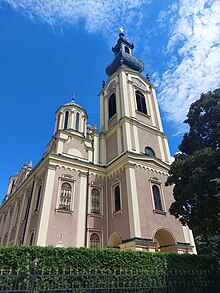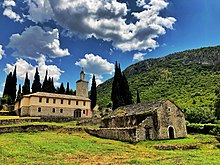Eastern Orthodoxy in Bosnia and Herzegovina


How often do Bosnian Orthodox Christians pray[1]
Several times a day (7%)
Once a day (21%)
A few times a week or
once a week (22%)
A few times a month
or seldom (34%)
Never (15%)
Don’t know/Refused (1%)





The
Roman Catholicism. Orthodox Christians in Bosnia and Herzegovina belong to the Serbian Orthodox Church. According to the CIA World Factbook, Orthodox Christians make up 30.7% of the country's population.[2]
History
The end of the
Stephen II Kotromanić in the late 1320s and was henceforth part of the Banate of Bosnia (later kingdom), in which the Roman Catholic Church and the indigenous Bosnian Church vied for supremacy. In this political climate, the Eastern Orthodoxy never seems to have penetrated the medieval Bosnia proper beyond Podrinje.[3][4]
The
Mehmed the Conqueror vowed to protect Orthodox Christianity and, like all Orthodox churches, the Serbian Orthodox Church enjoyed great support from the Ottoman state. The Ottomans introduced a sizeable Orthodox Christian population into Bosnia proper, including Vlachs from the eastern Balkans. The conversion of the adherents of the Bosnian Church also aided the spread of Eastern Orthodoxy. Later, areas abandoned by Catholics during the Ottoman–Habsburg wars were settled with Muslims and Orthodox Christians.[3] The Ottoman regime consistently favored the Orthodox Church over the Catholic and encouraged conversions of Catholics to Orthodoxy due to political expediency: while the entire Orthodox hierarchy was subjected to the sultan, the Catholics were suspected of conspiring with their brethren outside the Ottoman Empire.[4]
While Bosnian Catholics were only allowed to repair existing sacral objects, a large scale construction of Orthodox monasteries and churches throughout Bosnia started in the northwest in 1515. An Orthodox priest was present in
first Orthodox church was constructed between 1520 and 1539. By 1532, Bosnian Orthodox Christians had their own metropolitan bishop, who took up official residence in Sarajevo in 1699. By the end of the 18th century, the Metropolitan of Bosnia had authority over the Orthodox bishops of Mostar, Zvornik, Novi Pazar and Sarajevo. Even the high-ranking Orthodox clergymen, however, were very poorly educated and corrupt; they were reportedly ignorant of the basic principles of the faith, such as the Ten Commandments, confession, prayers and the importance of the cross. Syncretism was widespread among the Bosnians, with Catholics (as late as the 1880s) and Muslims celebrating the Orthodox slava.[3]
The tide eventually turned against the church, however, when Orthodox clergy renounced loyalty to the sultans and started encouraging and aiding peasant rebellions. The Ottomans abolished the
Patriarch Dimitrije
.
Serbian Orthodox Church in Bosnia and Herzegovina
Five eparchies (dioceses) of the Serbian Orthodox Church cover the territory of Bosnia and Herzegovina:
- Metropolitanate of Dabar and Bosnia, headed by metropolitan Hrizostom Jević, since 2017.[5]
- Eparchy of Zahumlje and Herzegovina, headed by bishop Dimitrije Rađenović, since 2018.
- Eparchy of Zvornik and Tuzla, headed by bishop Fotije Sladojević, since 2017.[5]
- Eparchy of Banja Luka, headed by bishop Jefrem Milutinović, since 1980.
- Eparchy of Bihać and Petrovac, headed by bishop Sergije Karanović, since 2017.[5]
Regional Council of Serbian Orthodox Church in Bosnia and Herzegovina consists of all five diocesan bishops. The Council is presided by the
Metropolitan of Dabar and Bosnia
.
Orthodox Christian sites of interest
- Serb Orthodox Cathedral (Sarajevo)
- Sarajevo Old Orthodox Church
- Church of Sveto Preobraženje
- Tavna (monastery)
- Tvrdoš (monastery)
- Žitomislić (monastery)
- Religion in Bosnia and Herzegovina
- Roman Catholicism in Bosnia and Herzegovina
References
- ^ https://assets.pewresearch.org/wp-content/uploads/sites/11/2017/05/09154356/Central-and-Eastern-Europe-Topline_FINAL-FOR-PUBLICATION.pdf [bare URL PDF]
- ^ CIA, World Factbook: Bosnia and Herzegovina, 2013 estimates, accessed 17 March 2021
- ^ ISBN 978-1603447249. Archived from the originalon 2016-03-04. Retrieved 2015-08-08.
- ^ ISBN 1850652120.
- ^ a b c "Communique of the Holy Assembly of Bishops | Serbian Orthodox Church [Official web site]". www.spc.rs. Archived from the original on 2018-01-15. Retrieved 2021-05-21.
Bibliography
- Bataković, Dušan T. (1996). The Serbs of Bosnia & Herzegovina: History and Politics. Dialogue Association. ISBN 9782911527104.
- Mileusnić, Slobodan (1997). Spiritual Genocide: A survey of destroyed, damaged and desecrated churches, monasteries and other church buildings during the war 1991-1995 (1997). Belgrade: Museum of the Serbian Orthodox Church.
- ISBN 9781405142915.


